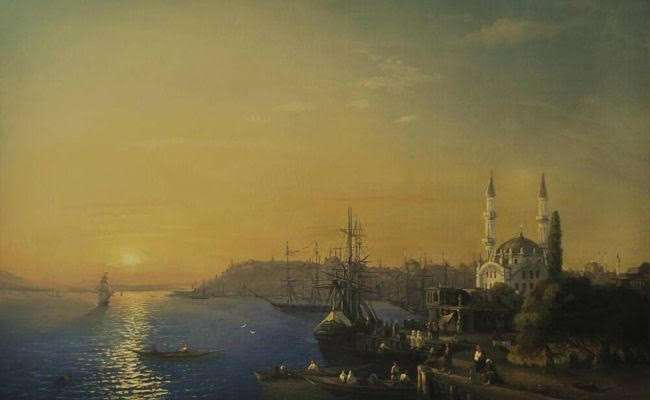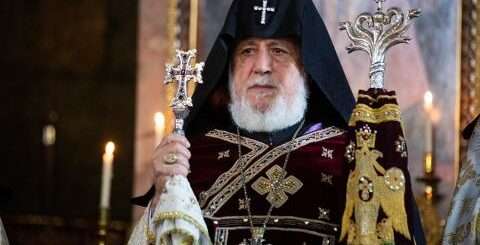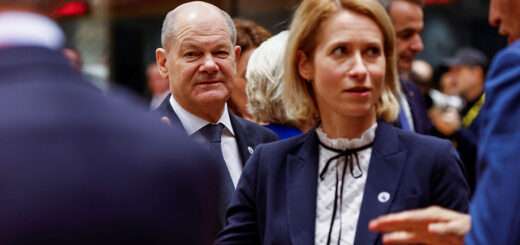“There have been worse times, but never meaner”: about Rex, the Sultan’s Order and the cradle of Armenians

EurAsia Daily
“At the end of the day, I would like to remember the great Armenian, Ivan Aivazovsky, on his outgoing birthday. One of his actions,” the author of the Thanos Click Telegram channel wrote on July 29
“Aivazovsky was personally acquainted with the Turkish Sultan Abdul-Aziz, who ruled from 1861 to 1876. The Sultan invited the artist to Constantinople. He commissioned several paintings that were painted in a short time. In total, almost 30 works with views of Constantinople and the sea were created.
The Sultan was so happy that he awarded Aivazovsky two orders of “Medjidie” and “Osmanie“ with diamonds. But in 1894-1896, the Hamid massacre occurred in the Ottoman Empire. The Turks massacred more than 150,000 Armenians.
The great Armenian was shocked. He grieved for several days. Then he hung Turkish orders on his dog Rex and went for a walk in Feodosia. When he came to the sea, he threw the orders into the sea. Yes, greatness is not in words, but in deeds,” the author concludes.
And he writes already on July 31, after the well-known act of vandalism in Nagorno-Karabakh, which was reported by many news agencies.:“It’s hot, I don’t want to write something heavier, I’ll feel sorry for myself and you. But, I will share some thoughts on current news. The peak of summer inactivity of people sometimes coincides with the peak of activity of inhumans. “Do not give what is holy to dogs, and do not throw your pearls before swine, lest they trample it under their feet.” Yes, I understand that this is said for a different reason, but you must agree, the destruction by Azerbaijanis of the monument to Ivan Aivazovsky on his birthday in Stepanakert perfectly visualizes this truth. Who is he to them? A genius? A great marine artist? A man who has stretched kilometers of water supply for his money to the Crimean towns and villages languishing without water? And this saved the lives, including the Crimean Tatars, direct relatives of the Caucasian Tatars. No, he is, first of all, an Armenian for them. And about the rest, high, they basically do not know, like those dogs and pigs from the biblical parable.”
And now a part of the post by the same author from August 1. As they say, in continuation of the topic:
“A few short thoughts on one topic: A toponymic war has now begun between Russia and Azerbaijan. In which TASS immediately backed out. Said Stepanakert — keep it to the end. I couldn’t, I gave up, so get a Konigsberg from Baku Amshara to Kaliningrad.
I understand that TASS is waiting for a long recovery after Guzman, like after a coma. But it is still clearly visible that the recovery will be very long, if it can be successful at all.”
And now a little history. The outstanding Armenologist Kim Bakshi spoke enthusiastically:
“Artsakh, Karabakh has been in the history of Armenian culture for centuries. Matenadaran, that is, a repository and has preserved the most valuable thing for the people of Armenia — the holy book, the manuscript. He was a treasure trove full of invisible life-giving seeds of culture, now in demand in the world, so necessary for people today.”
In the last book he published, Bakshi told about visiting the cradle of the Armenians and the great Temples. Let’s read an excerpt from one chapter together, dear readers. I can assure you, it’s worth it!***
Gandzasar. Prince of Princes Hasan Jalal Dola
I don’t know if there is such an effect in the history of other nations, but in The heyday of art in Armenia did not necessarily coincide with the bright peaceful years, which are very rare in Armenia. The seventh century marks the Arab conquest. But it was the golden age of Armenian architecture. And in the first half of the XIII century, under the yoke of the Seljuk Turks, and since the 30s, under the heavy yoke of the Mongols, its silver age flourished!
I found this list of famous temples of the XIII century from Anatoly Yakobson, a great connoisseur of them: Arich is the very beginning of the XIII century, 1201. The famous Geghard monastery — 1215, Hovhannavank — 1216, Gandzasar was founded in the same year; Makaravank — 1241, Khorakert — 1251 and Arates – 1265. These are all outstanding creations of the Armenian genius, classics of architecture.
Why did Anatoly Yakobson put them together in a special work dedicated to Gandzasar? He found a number of parallels with each of these temples in Gandzasar in architectural solutions or in sculptural decoration, which allowed him to draw a conclusion about Gandzasar temple as the artistic and spiritual center of Artsakh: this beautiful architectural creation embodies all the best achievements of Armenian architects of the XIII century and it can rightfully be called the encyclopedia of Armenian architecture of this century.
The walls of the temple and the adjacent narthex are covered with inscriptions. Here is one of many — very important, construction:
“In the name of the Holy Trinity, the Father and I, the servant of God Jalal Dola Hasan, the son of Vakhtang, the grandson of Hasan the Great, bnakavor (inhabitant, inhabitant), the ruler of the high and great Artsakh region, the king of Khokhanaberd with vast nahangs (regions), ordered this inscription to be knocked out.
My father, before his death, irrevocable departure from this world, bequeathed to me and my mother Khorishah, the daughter of the Grand Duke of princes Sarkis, to build with the help of the Giver of blessings (God) a church and a tomb of our fathers in Gandzasar, the construction we began in the year 765 of the Armenian calendar (1216).
And when the eastern wall was erected above the window, my mother, having renounced life in this light, went to Jerusalem for the third time, where, wearing a hair shirt and spending many years in a hermitage, at the gates of the Church of the Resurrection, she rested in Christ on Easter Day, and was buried there. We, remembering all the misfortunes that lie in wait in life, hurried to complete the construction and finished with the grace and blessing of the All-Merciful God in 1238.”
Prince Sarkis would have known that after 800 years in Baku will be told about some “Albanian churches” where Armenian genius masters “simply painted the walls and made inscriptions in their own language.”
And the destruction of the cemetery of medieval Armenian khachkars near the city of Julfa in the territory of the Nakhichevan Autonomous Republic, an autonomous entity (exclave) within Azerbaijan, will be called a necessity for the construction of a shooting range.
“There have been worse times, but there have never been meaner,” Nadezhda Khvoshchinskaya wrote in the nineteenth century.
Toponymic games do not end with anything good, as history shows. You can and should do real things. Take, for example, the example of the relatives of political scientist Sergei Mardan, after whom the urban-type settlement of Mardakan is named, which flourishes thirty-four kilometers from the Baku station. People worked with dignity, hence the respect for them.
The Moscow-Baku confrontation will not end well, we need to look for a compromise. In order to return Russian journalists and tourists from Baku zindans. And to return tens of thousands of sellers of melon crops to their historical homeland.
By the way, about the “dill”. The Azerbaijani-Ukrainian “kisses in the glands and gums” is not about “annoying the Kremlin.” Dig deeper: full-fledged military-industrial cooperation. Read the news feeds for those who are curious.
Here, fresh: ways to deepen the strategic partnership between Baku and The issues were discussed by Kiev at the meeting of Ukrainian Ambassador Yuriy Gusev with Assistant to the President of Azerbaijan — head of the Foreign Policy Department Hikmet Hajiyev.
The head of the Ukrainian diplomatic mission said:
“A fruitful meeting with Hikmet Hajiyev, Assistant to the President of Azerbaijan. We discussed ways to deepen the Ukrainian-Azerbaijani strategic partnership. We are grateful for the steady support and solidarity with Ukraine.”
Honestly and frankly. Without any bluntness and conventions. While TASS is rewriting the headlines, and Markov is talking about our guilt for the “downed plane”, mythical payments and mythical punishment of the perpetrators who actually shot down the Russian helicopter.
And in conclusion, just one question. Did the Russian Patriarch really fly in May this year not only to present the wife of the Azerbaijani president with the highest order of the Russian Orthodox Church?





